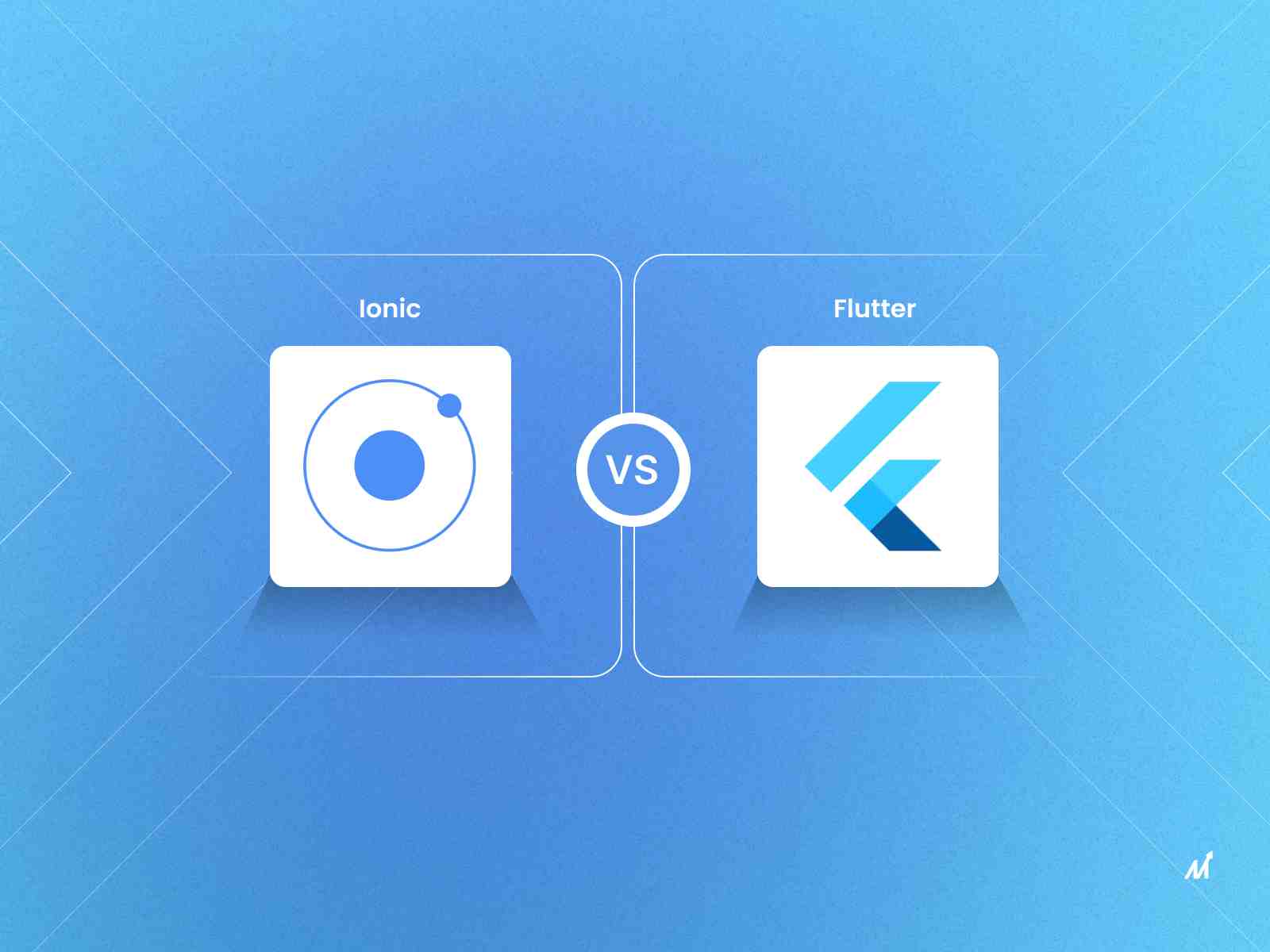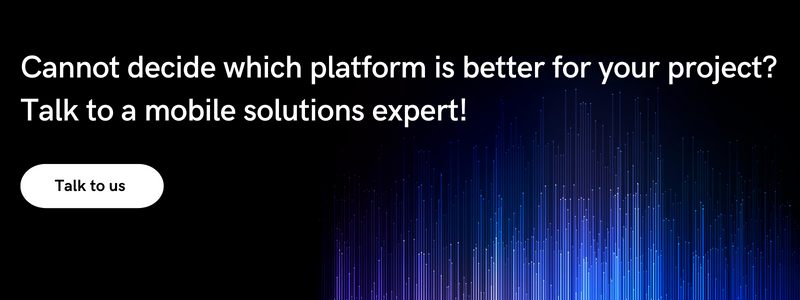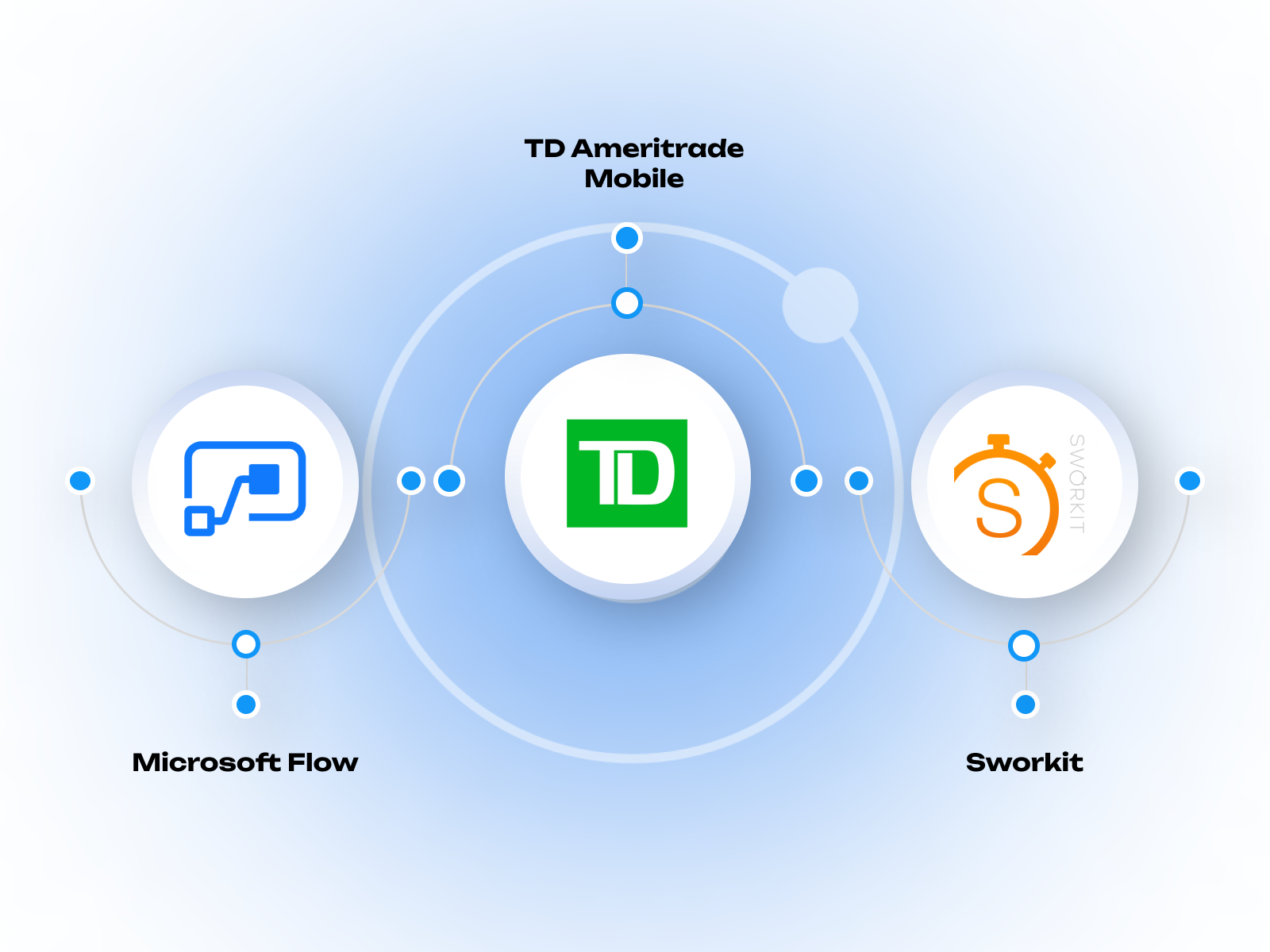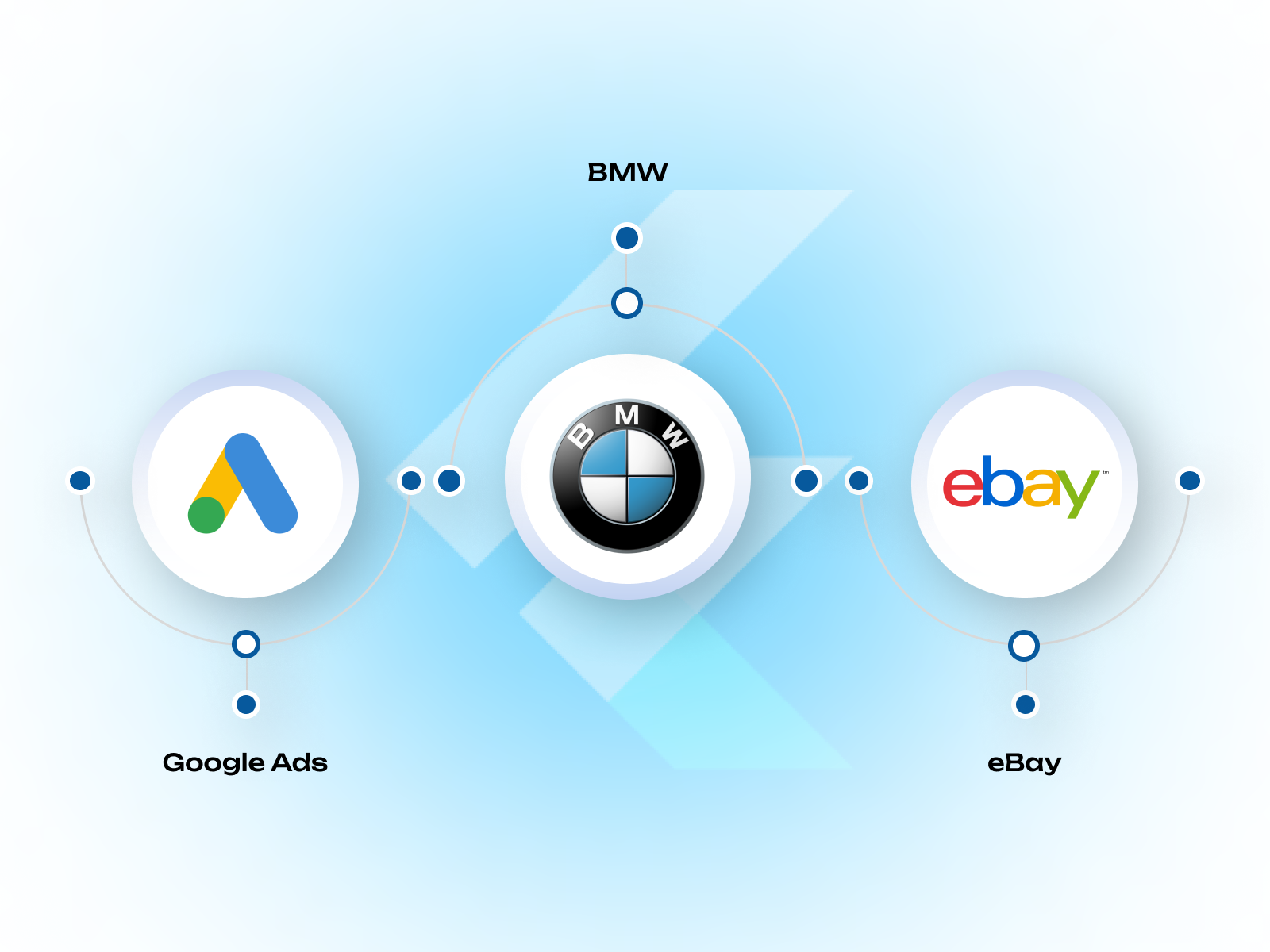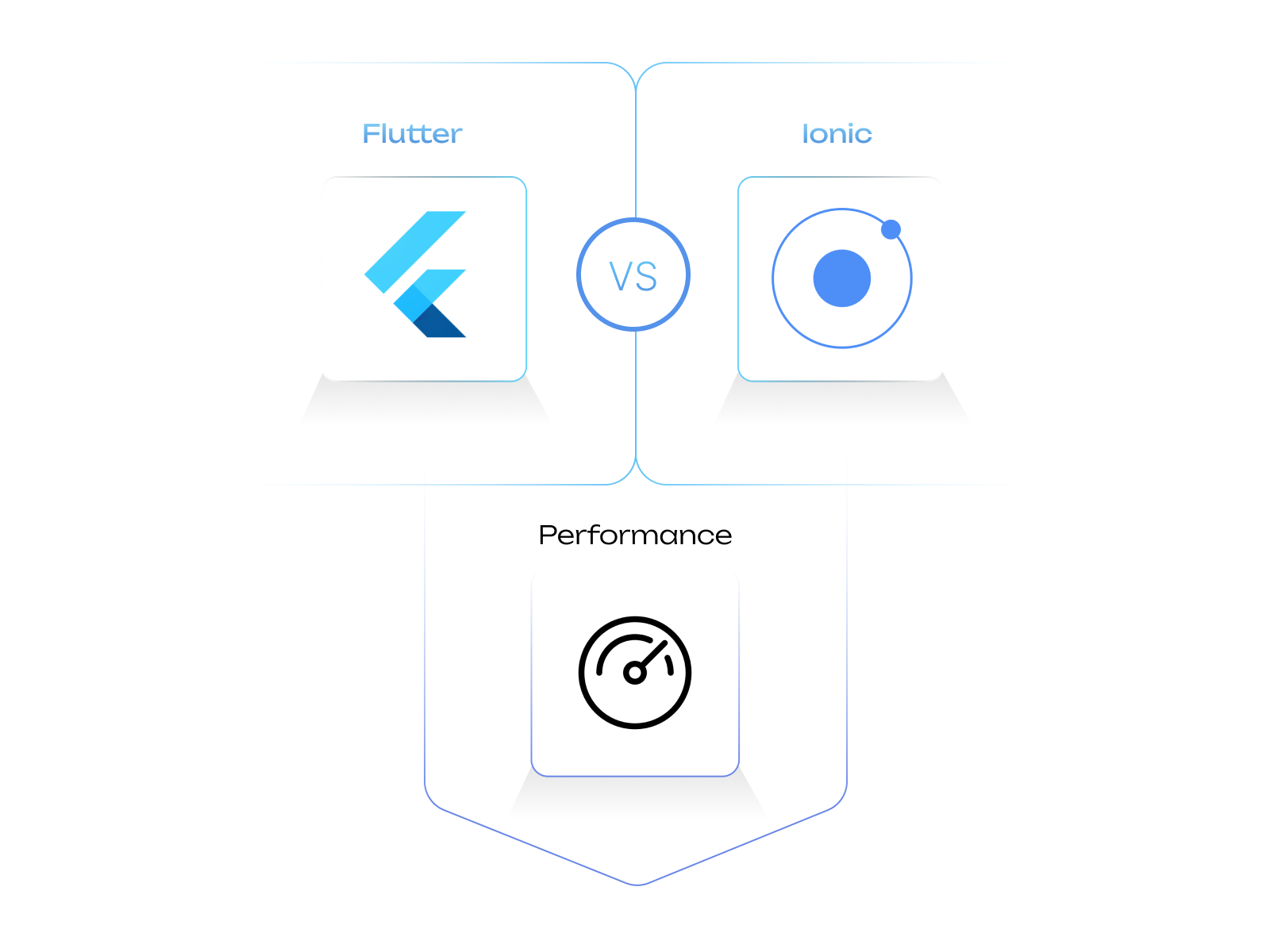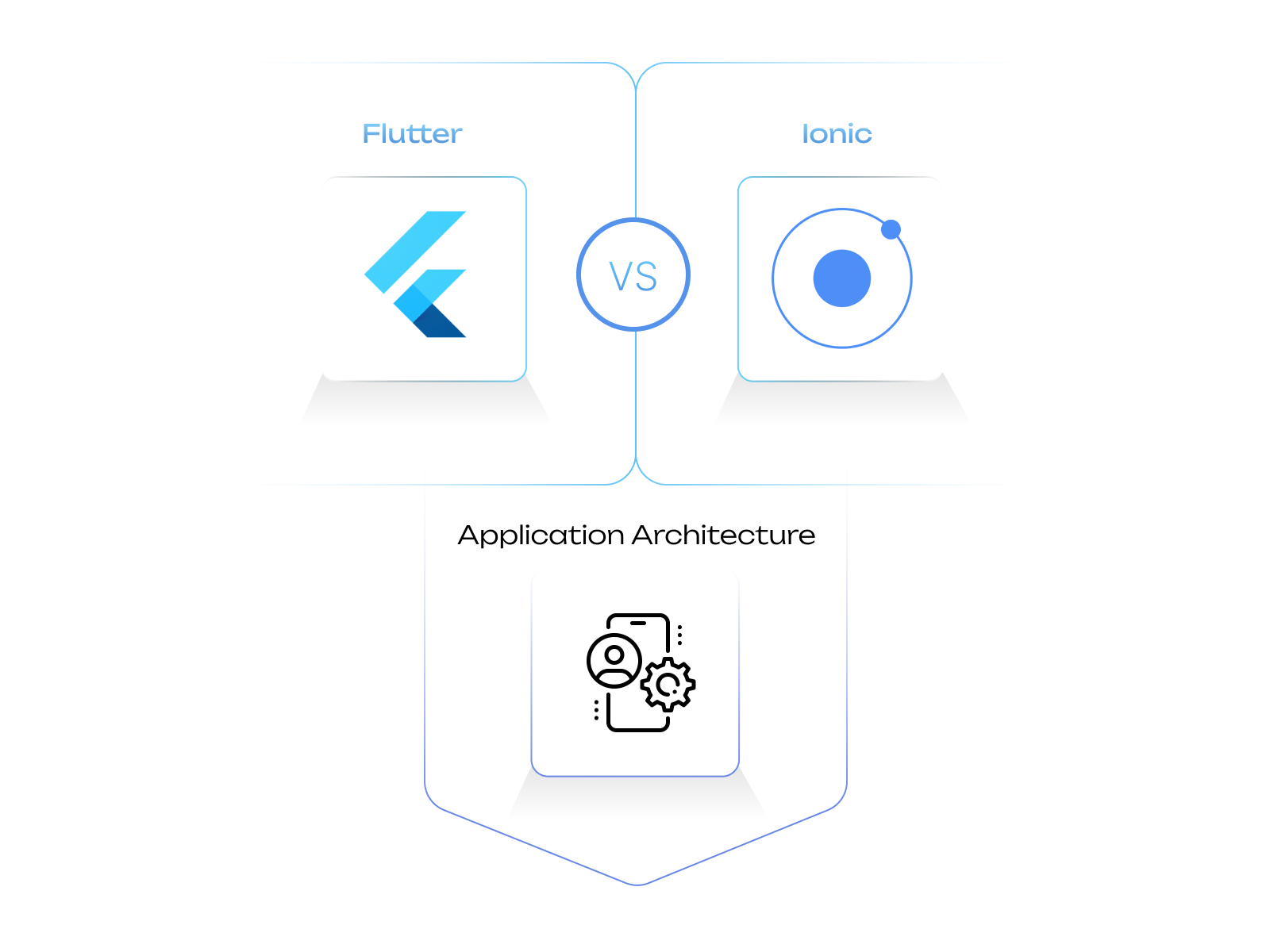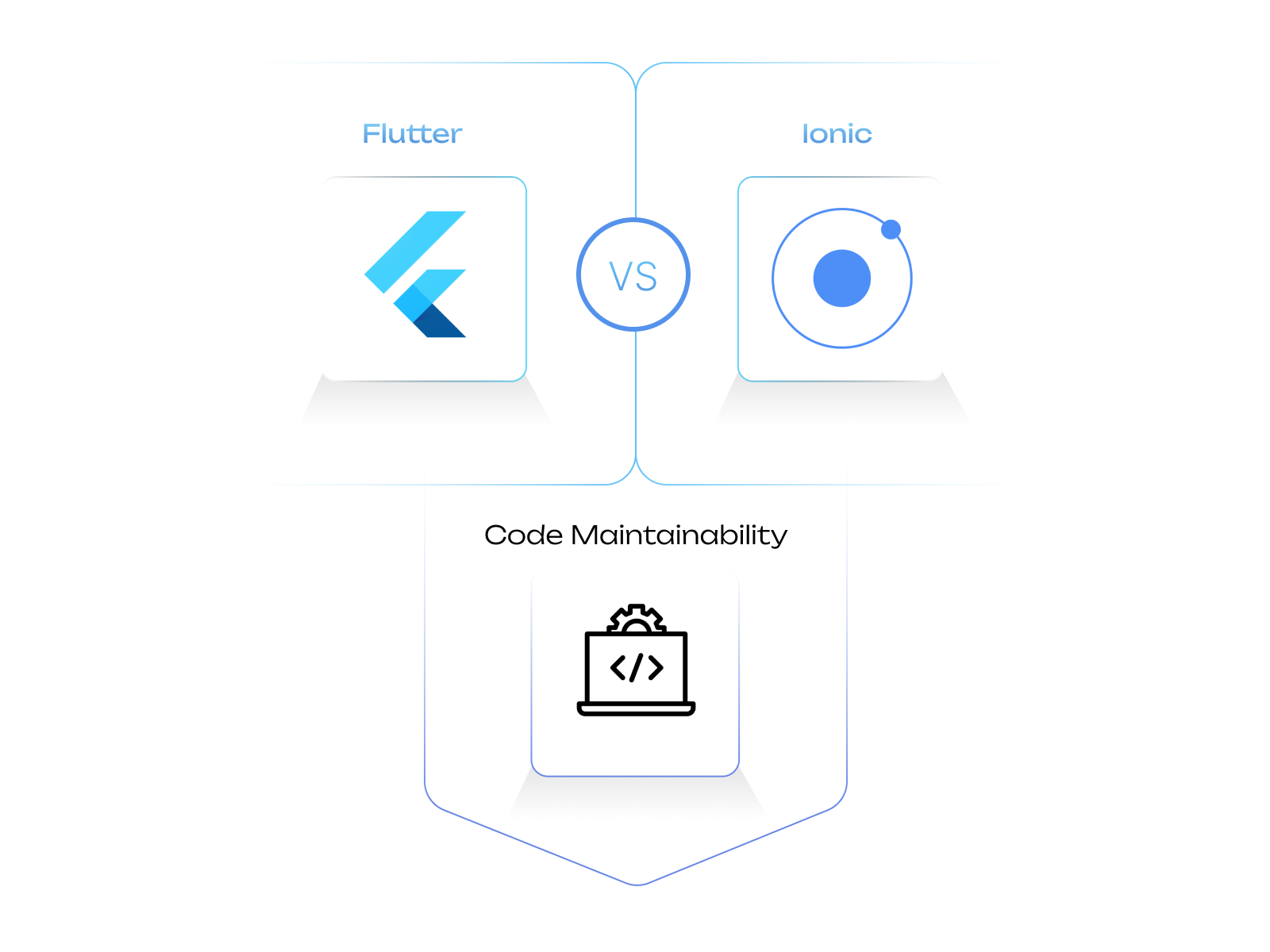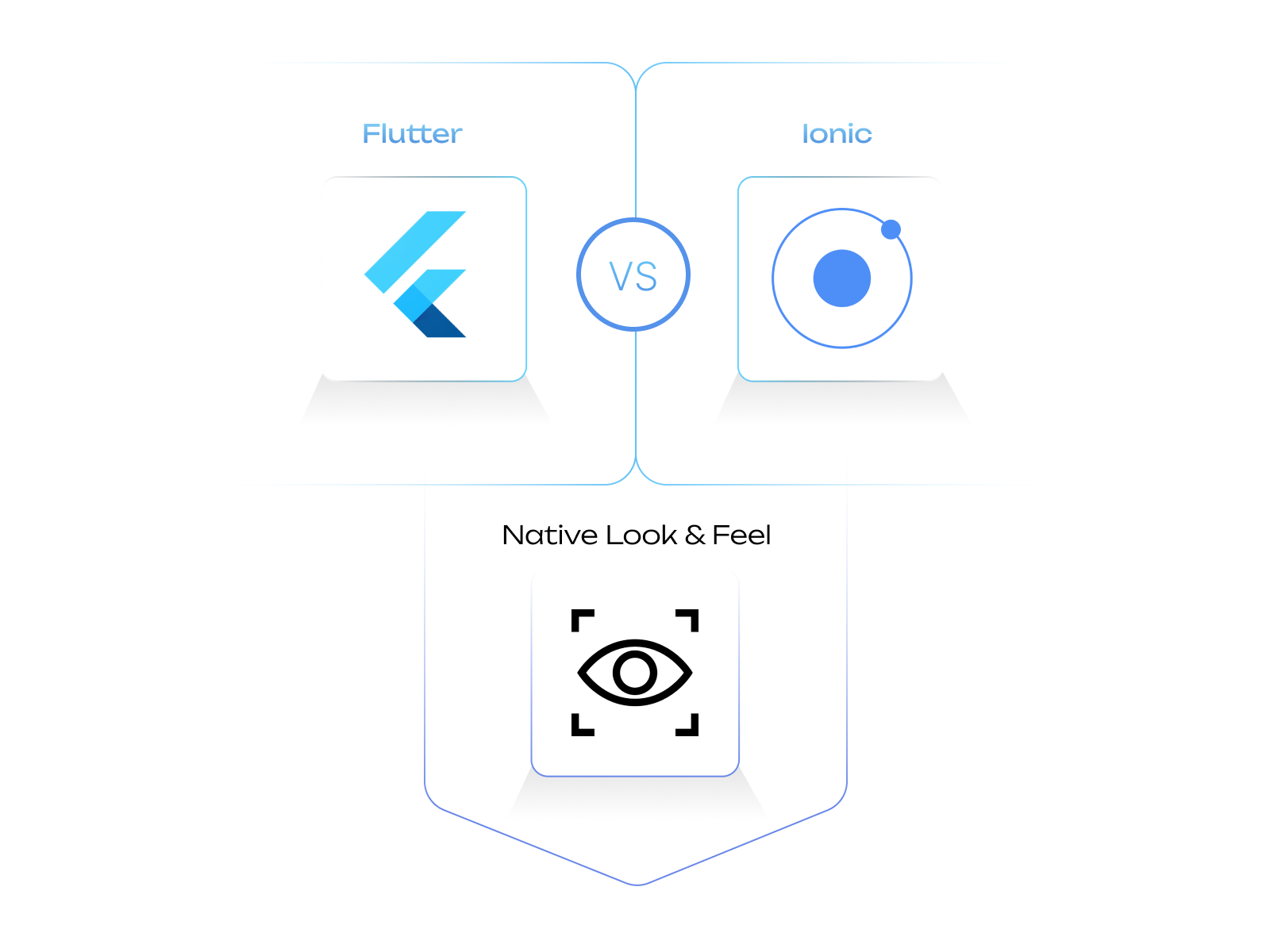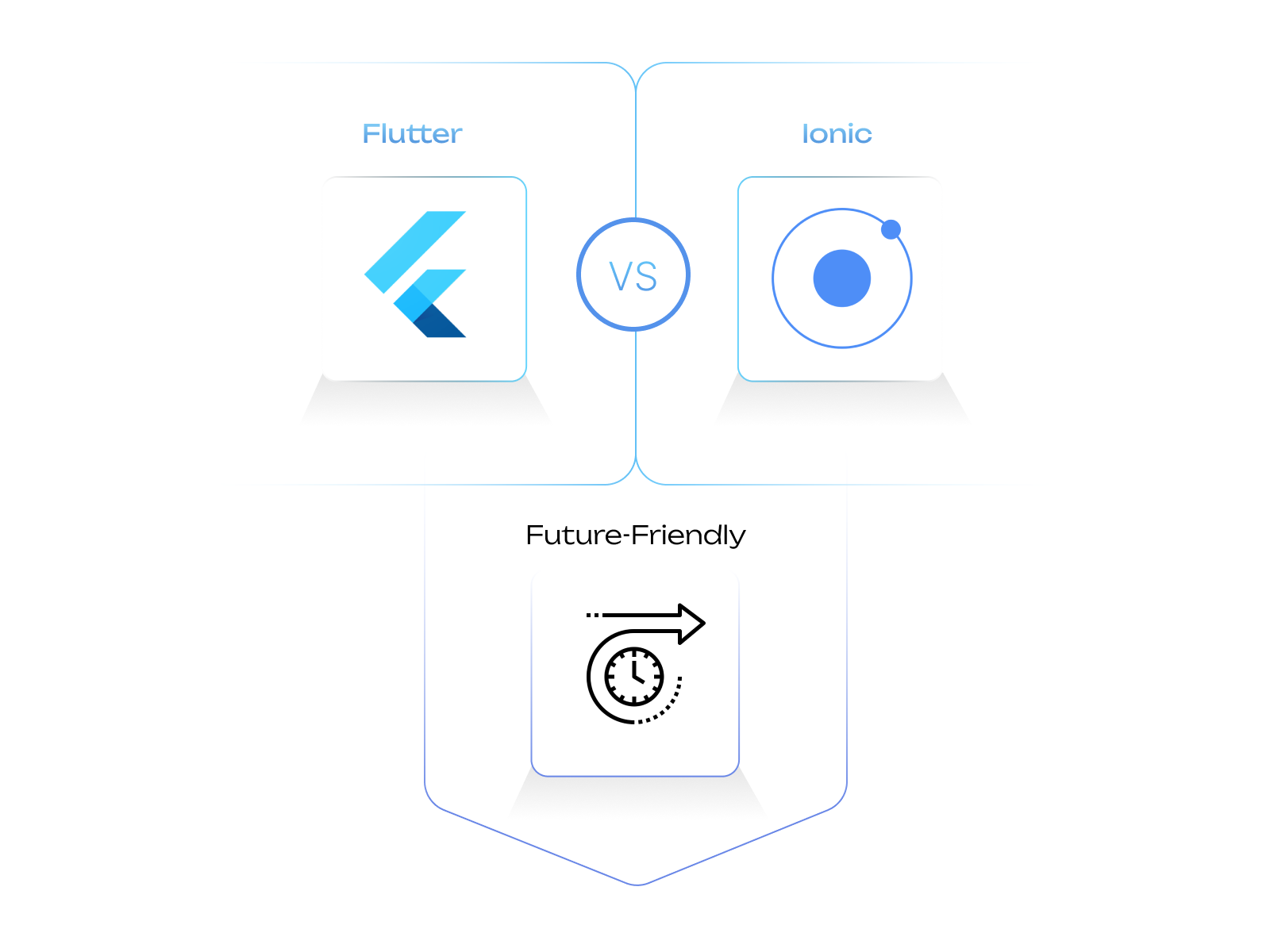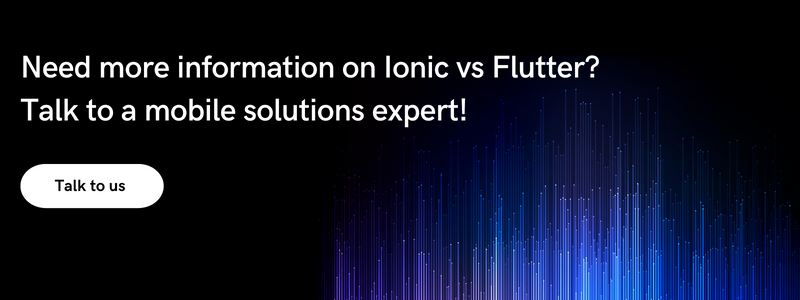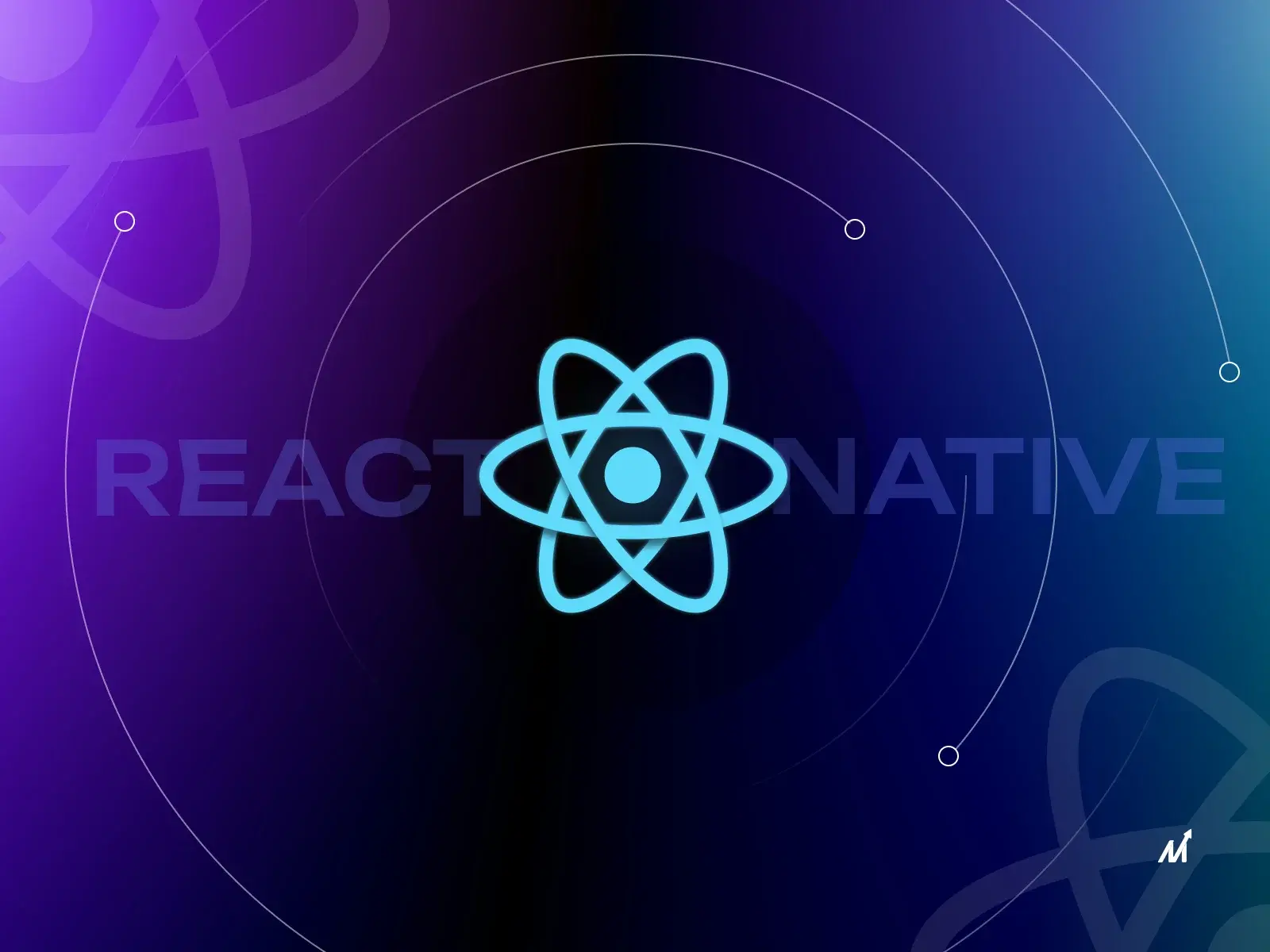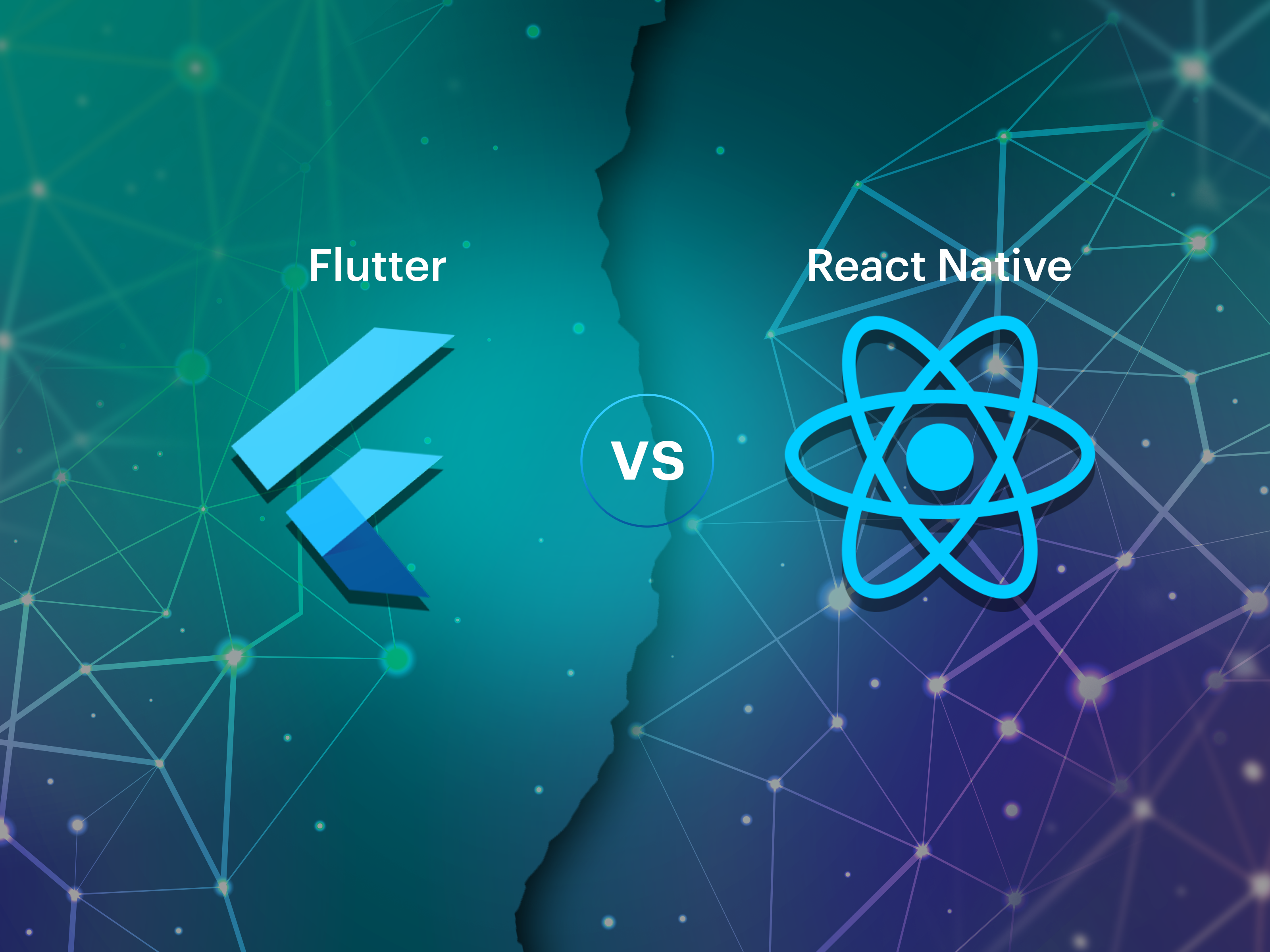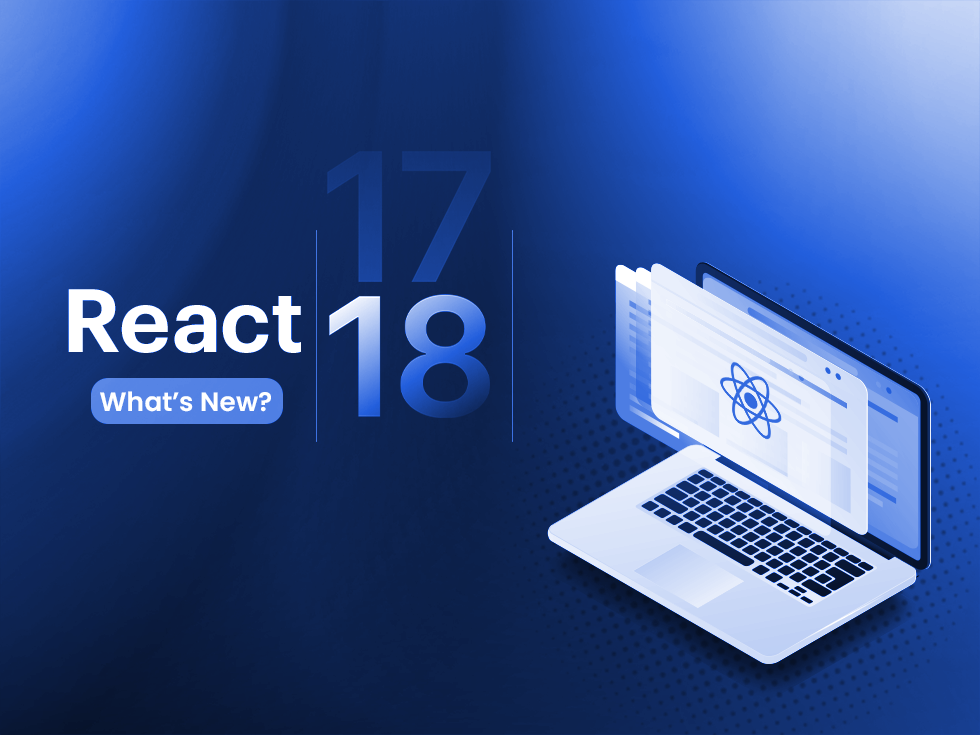Ionic vs Flutter: Facts & Stats
How do I choose between Ionic vs Flutter? Both are highly regarded mobile app development frameworks and offer tools to support businesses in realizing the notion. However, selecting the best one could still be confusing.
Reaching as many users as possible across multiple platforms and devices is imperative to succeed in mobility. Due to users having access to the product or service on multiple platforms, a cross-platform mobile app is an additional benefit. There is a common vision behind Ionic vs Flutter – creating beautiful, high-performance apps that work everywhere. Both of them are helpful as well as easily accessible by the developers.
Here are some interesting statistics on Ionic’s market share:
-
Ionic is preferred by 86% of developers for mobile development
-
The Ionic framework is used to generate about 5 million applications
Here are some interesting figures on Flutter’s market share:
-
To create cross-platform mobile applications, 39% of people utilize Flutter globally.
-
68.8% of people in the developing world adore Flutter.
-
7.2% of the community chose Flutter due to the popularity of its libraries and tools.
Our comparison in this article will show how Ionic and Flutter perform, how their components work, and other aspects so you can choose the right technology for your application.
Overview Of Ionic
The first version of Ionic came into existence in 2013 when three coders named Max Lynch, Adam Bradley, and Ben Sperry built an open-source UI toolkit on AngularJS. On 25th July 2019, the latest yet stable version of the Ionic cross-platform app development framework was released. Since then, Ionic has become one of the most popular cross-platform app development frameworks for providing efficient performance with minimum DOM manipulation.
Ionic is a well-integrated, open-source framework and a UI toolkit used to build high-performing desktop & mobile applications. This is undoubtedly the go-to platform for development.
It uses well-known languages like HTML, CSS, React Native, Angular, Vue.JS, and JavaScript for integration with the backend. Therefore, the whole process becomes more accessible. As a result, the development becomes flawless.
The Ionic framework primarily aims to improve the frontend user experience by equipping hybrid app developers with vast libraries of mobile-optimized UI components, tools, and gestures to build future-ready mobile apps that reciprocate impact and increase customer engagement.
Benefits Of Ionic
Ionic is the only framework that allows developers to create a single, simple-to-use JavaScript codebase. Moreover, it provides a lot of space for the developers to implement the tools for improvement.
In addition, here are a few benefits of using Ionic for cross-platform application development.
-
Platform-Independence — Firstly, being a platform-independent framework, Ionic reduces time and effort. It cut short the resources employed to build a cross-platform app with a native look and feel.
-
Simplified Developer Interface — Ionic uses a capacitor that saves development time and creates an easy-to-use interface to access native API and native SDK on platforms. Developers can make some real deal out of it regarding time management methods.
-
Community Support — Ionic is built on top of popular technologies such as Cordova and Angular and has an active community for support. This makes it easy to access quick responses to queries while developing cross-platform apps.
Further Read: Ionic Framework: Pros And Cons Of Building Apps With Ionic
Drawbacks Of Ionic
We’ve covered some of the benefits of the Ionic mobile application development framework; now is the time to look at some disadvantages.
-
Absence Of Hot Reloading — Ionic doesn’t accommodate hot reloading and refreshes the whole app whenever the developer changes, slowing down the development speed. This can be an issue, among other things, when the app is developed.
-
Security Threats — Using older versions of Ionic will not provide code uglification, even though this is not the case on the newer versions.
Overview Of Flutter
According to the 2021 developer survey, Flutter not only takes first place for the most popular cross-platform mobile framework but also, 42% of developers start with Flutter when developing mobile apps. At the same time, most of the developers also use flutter for development.
Additionally, Google’s brainchild – Flutter, is a relatively scalable and fast cross-platform framework that functions as a UI toolkit to create feature-rich and powerful cross-platform applications with surprisingly impressive features. It supports the Dart programming language due to its intuitive interface, a library of elements, and many templates. It utilizes Swift and Objective C for iOS integration and Java for Android.
The framework’s thriving user community with open-source libraries, resources, and answers to all programming dilemmas sets the Flutter framework apart from the rest of the mobile app development frameworks. It’s equally simple to use and easily manageable.
Further Read: How Is Flutter 2.0 Better Than Flutter 1?
Benefits Of Flutter
While comparing Ionic vs Flutter, Flutter has many decent selling points, like:
-
Hot-Reload — One of the unique features of Flutter is Hot Reload. The changes are visible as soon as the Flutter app developer or designer updates the code. It’s as simple as that in reality.
-
Rich & Powerful Widgets — Combined with Rich Widgets, the Flutter framework equips mobile app developers with an extensive library to add rich, layered functionalities in apps that are compatible with any operating system. This is surely a huge advantage for the developers.
-
Flawless Back-End Integration — Whether the backend is in Java supporting Android or Objective C or Swift supporting iOS, Flutter integrates smoothly enough to make the front end look as native as the backend. That is what makes it surprisingly easy to operate.
Drawbacks Of Flutter
It is always advised to remember that every tool or technology has its definite downsides. They may or may not affect the app development process for businesses. But here are some common disadvantages businesses may experience:
-
Immaturity Of The Platform — Compared to Ionic, Flutter is competitively a new platform launched less than three years ago; therefore, one major downside of using Flutter for mobile app development is the lack of community-generated tools and libraries.
-
Platform Compatibility — While Flutter offers cross-platform interoperability, apps like tvOS, Android Auto, CarPlay, and watchOS won’t function flawlessly. Similarly, this is another aspect to consider about it.
Ionic vs Flutter: Popular Apps
The best way to judge the Ionic vs Flutter framework is to see the differences between the real-world use cases in the first place. This can give us an overall idea of the whole scenario. People can decide depending on that information. Here’s a list of some tech giants eventually entrusting Ionic and Flutter to meet their market needs.
Popular Apps Built With Ionic
-
Microsoft Flow: Ionic was linked with Azure and AAD authentication to develop a process automation engine for enterprise-grade, lag-free performance.
-
TD Ameritrade Mobile: For new and experienced traders, TD Ameritrade Mobile created a user-friendly application that reinforced security by utilizing facial and touch verification to dissuade hackers.
-
Sworkit: The company reduced the additional labor needed by over $200K a year and cut the development time in half by using a single codebase to create both iOS and Android apps.
Popular Apps Built With Flutter
-
Google Ads: Creating a portable user interface for iOS and Android involved the usage of static utility classes from Flutter, Dart packages, and Firebase Admob plugins.
-
BMW: Created high-performance user interfaces while managing them using Flutter bloc.
-
eBay: They utilized powerful and programmable edge-powered AI technologies to create autoML for eBay Motors by integrating Flutter and Firebase.
Ionic vs Flutter: Detailed Comparison
Since businesses now have a solid understanding of both frameworks, let’s compare Flutter and Ionic along a few key parameters. This will enable businesses to select the best option for their project.
Ionic vs Flutter: Performance
The Ionic apps deliver 60 FPS on desktop and mobile, which is a performance-related factor. They use pre-existing plugins to accelerate development and offer a hybrid methodology. At most, 1.8 seconds are spent interactively during the framework. Ionic is the best at providing hardware-accelerated transitions, pre-rendering, and gestures tuned for touchscreens despite its framework not being native.
In comparison, Flutter performs better than its fiercest opponents. Due to the native components’ built-in availability, there is no requirement for a bridge to facilitate communication between native modules. If the performance test results are to be trusted, the “hello world” app consistently rendered each frame in less than 16 milliseconds and performed at a frame rate of 60 FPS.
Ionic vs Flutter: Application Architecture
To create complex cross-platform, single-page apps tailored for mobile devices, Ionic uses Angular.js MVC architecture, a software design pattern that consists of a Model View Controller. This design enables concurrent development by numerous developers, reducing turnaround time and boosting output. The architecture also makes it possible to create several Views, which protects the application from repeated iterations.
Flutter has a layered structure. The top-level root function sometimes referred to as platform-specific widgets, is where the hierarchy of an actual application built on this framework starts. Simple widgets designed to communicate with the renderer and platform layers are then introduced. Animation gestures are used to move API calls to the application’s base layer, which is located above the rendering layer. It also goes by Scaffold and is run by an embedded platform-specific C or C++ engine.
Ionic vs Flutter: Code Maintainability
Code maintenance for Ionic applications is a complex problem because developers frequently need to change the codes to maintain the application’s reliability. And to make matters worse and the experience more irritating, the backward compatibility often breaks.
It is quite simple to maintain a Flutter application. Developers can find problems faster, find external tools more efficiently, and support third-party libraries because of the code’s simplicity. Furthermore, the Hot Reloading function immediately solves the current issues. Ionic takes substantially longer to update apps with high-quality changes and make quick adjustments.
Ionic vs Flutter: Native Look & Feel
Flutter and Ionic will both essentially appear native to the user.
Flutter and Ionic automatically adapt the design of their UI elements to match the platform that the app is running on — Material Design for Android and Cupertino for iOS — even though neither framework employs the native UI elements of each platform.
Through a library of pre-built plugins and a set of tools for creating custom plugins as necessary, both systems give access to platform services and native APIs.
The native mobile implementation of Flutter is very opinionated; it should be emphasized. Businesses must become familiar with Flutter’s approach to interacting with iOS and Android if they plan to use it for custom native programming. This leads naturally to the following subject, which is knowledge and skill set.
Ionic vs Flutter: Future-Friendly
The final factor to consider is how long the project will endure and how much freedom and flexibility businesses will have as their software develops.
For Flutter developers, this means placing all of their eggs in the Flutter basket, which means that in the event that Google abandons the project (you know they never do, right? ), developers will be left with a set of skills and a codebase that are essentially homeless.
Using Ionic, businesses place their bet on the web, ensuring that even if they decide to develop for other platforms in the future, all of their work will adhere to open web standards. Businesses may use any JS framework with Ionic because it is based on Web Components. This is significant because it could change tomorrow even if React and Vue are popular. Additionally, Ionic will allow benefiting from whatever the future holds.
Ionic vs Flutter: Comparison Table
| Parameter | Ionic | Flutter |
| Language(s) | HTML, CSS, JavaScript | Dart |
| UI elements | Standard-based web components | Proprietary widgets |
| Native API access | Cordova and Capacitor from Native plugin library | Flutter native packages from the Native plugin library |
| Runtime | Web browser | Custom graphics machine |
| Offline access | Yes | Yes |
| Mobile performance | Very good | Excellent |
| Type | Software framework | Application framework |
| License | MIT License | New BSD License |
| Hot Reload | No | Yes |
| Performance | Moderate | Amazing controller |
| Testing | Any browser | Mobile device or emulator |
| Code reusability | 98% of code is reusable | 50-90% of code is reusable |
| Typical use cases | Hybrid app development, App with hardware functionality, MVC mobile apps, and likewise. | MVP applications, Apps with material design, high-performance apps with a Skia rendering engine, and more. |
| Deployment Options | Mobile, Desktop, Web, PWA | Mobile, Desktop, Web |
| Popular apps | Diesel, Sworkit, Microsoft Flow, Pacifica, Watch | Google Ads, BMW, Tencent, KisterMe |
Ionic vs Flutter: The Winner
After reading every section of this post, we hope businesses understand how Ionic and Flutter differ and how they are similar. We’ve gone through every feature of Flutter while comparing it with the Ionic framework in this article.
It is always challenging to choose a particular framework. The decision-making process is greatly facilitated if businesses know their business objectives and user requirements. However, it is advisable to use specialized Ionic developers if the application structure is complex. Employ a professional team for Flutter app development if the projechttps://markovate.com/ionic-app-development/t involves complex user requirements.
The business purpose businesses choose to align with, the location and method of the app launch and the knowledge businesses now possess or hope to acquire will ultimately determine their chosen framework. To gain insight, it is, therefore, best to get in touch with Markovate, a reputable mobile application development company. Our knowledgeable advisors will lead businesses along the appropriate road and assist in making the best technological decision.

I’m Rajeev Sharma, Co-Founder and CEO of Markovate, an innovative digital product development firm with a focus on AI and Machine Learning. With over a decade in the field, I’ve led key projects for major players like AT&T and IBM, specializing in mobile app development, UX design, and end-to-end product creation. Armed with a Bachelor’s Degree in Computer Science and Scrum Alliance certifications, I continue to drive technological excellence in today’s fast-paced digital landscape.

